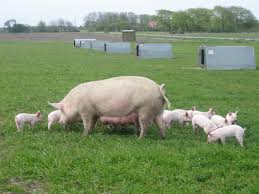Performance, carcass quality and cost benefit of pigs fed graded levels of dried brewers’ grains
Keywords:
carcass quality, dried brewers' grains, performance, pigsAbstract
Twelve Large White weaner pigs with average live weight of 7.55 kg (range 7.00-7.90 kg) were used to evaluate the performance, carcass quality and cost benefit of pigs fed graded levels of dried brewers’ grains (DBG). The diets contained 0, 25, 35 and 45% DBG in treatments T1, T2, T3 and T4 respectively. The experiment was in a completely randomized design (CRD) with each treatment being replicated three times. Fortnightly live weight, daily feed intake, feed cost and final carcass quality of pigs were recorded. Results showed that pigs fed T3 had significantly (P<0.05) higher live weight gain than other treatments during all the stages. However, pigs on T4 had significantly (P<0.05) higher feed intake (1.32 kg) than those on other treatments during the weaner stage. At the grower stage pigs fed on T3 had weight gain and feed conversion ratio (FCR) similar to the control diet. Back fat (1st rib) thickness, dressing out percentage and carcass length in T3 diet was significantly (P<0.05) reduced. There was also a reduction of feed cost with increased inclusion of DBG; with diet T3 having the highest gross margin and T2 had the lowest. It is concluded that in growing pigs the inclusion of 35% DBG in pig diets gives highest economic return without affecting performance.
References
Aguilera-Soto, J.I., Ramirez, R.G., Arechiga, C.F., Gutierrez-Banuelos, H., Mendez-Llorente, F., Lopez-Carlos, M.A.,
Pina-Flores, J.A., Rodriguez-Frausto, H., Rodriguez-Tenorio, D., 2009. Effect of fermentable liquid diets based
on wet brewers grains on performance of growing pigs. J. Appl. Anim. Res., 36 (2), 271-274.
Albuquerque, D.M., de, N., Lopes, J.B., Segundo, L.F., de, F., Brandão, T.M., Ribeiro, M.N., Ramos, L., de, S.N.,
Figueirêdo, A.V., de., 2012. Dehydrated brewery residue for pigs in the growth phase under high temperature
conditions. Rev. Bras. Zoot., 41 (7), 1784-1788.
Amaefule, K.U., Onwudike, O.C., Ibe, S.N., Abasiekong, S.F., 2006. Performance, cost benefit, carcass quality and
organ characteristics of pigs fed high graded levels of brewers' dried grain diets in the humid tropics. Pakistan
J. Nutr., 5 (3), 242-247.
Amaefule, K.U., Onwudike, O.C., Ibe, S.N., Abasiekong, S.F., 2009. Nutrient utilization and digestibility of growing
pigs fed diets of different proportions of palm kernel meal and brewers dried grain. Pakistan J. Nutr., 8 (4),
-367.
A.O.A.C., 1990. Official methods of Analysis. Association of official Analytical Chemists, Washington DC USA.
Canibe, O., Hojberg, Badsberg, J.H., Jensen, B.B., 2007. Effect of feeding fermented liquid feed and fermented grain
on gastrointestinal ecology and growth performance in piglets. J. Anim. Sci., 85, 2959-2971
Chenost, M., Mayer, L., 1977. Potential contribution and use of agro-industrial by-products in animal feeding. In,
New feed resources proceedings of a technical consultation held in Rome, 22-24 November, 1977 1-
http,//www.fao.org/DOCREP/004/X6503E/X6503EOO.HTM
Kornegay, E.T., 1973. Digestible and metabolizable energy and protein utilization values of brewers’ dried byproducts for swine. J. Anim. Sci., 37 (2), 479-483
Leick, C.M., Puls, C.L., Ellis, M., Killefer, J., Carr, T.R., Scramlin, S.M., England, M.B., Gaines, A.M., Wolter, B.F., Carr
S.N., McKeith, F.K., 2010. Effect of distillers dried grains with solubles and ractopamine (Paylean) on quality
and shelf-life of fresh pork and bacon. J.Anim. Sci., 88,2751-2766.
Luu, H.M., Tran, C.B., Nguyen, N.X.D., Bui, P.T.H., 2000. Composition and nutritive value of rice distiller’s byproducts (hem) for smallholder pig production. Sustainable Livest. Product. Local Feed Res. Proceedings
National Seminar –Workshop .UAF, SIDA-SAREC.http,//www. mekarn .org/sarec2000/manh.htm.
Luu, H.M., Tran, C.B., Nguyen, N.X.D., Lindderg, J.E., 2003. Effects of replacement of fish meal with rice distillers
waste (hem) on performance and carcass quality of growing pigs. (Editors, Reg Preston and Brian Ogle).
Sustainable Livestock Production on Local Feed Resources.Proceedings Final-Seminar-Workshop.UAF, SIDASAREC. Http, // www.merkan. org/Saec03/manhcatho03.htm.
McDonald, R.A., Edward, J.F.D., Greenhalgh, J.F.D., Morgan, C.A., 1988. Animal Nutrition (5ed). Pearson Education
limited, Edinburgh United Kingdom.
Meffeja, F., Njifutie, N., Manjeli, Y., Tchoumboue, J., Tchakounte, J., 2007. Comparative digestibility of diets
containing ensiled brewer's grains, palm kernel cake or cocoa pod husk in growing finishing pigs in Cameroon.
Livest. Res. Rur. Dev., 19 (5), 70.
Mpepereki, S., 2006. Soya Production, Talking Farming, (Zimbabwe Broadcasting Television show, 10 January
.
Mutambara, J., 2013. A preliminary review of regulatory constraints affecting pig industry in Zimbabwe. Livestock
Research for Rural Development. Volume 25, Article #43. Retrieved June 18, 2014, from
http,//www.lrrd.org/lrrd25/3/muta25043.htm.
National Research Council., 1988. Nutrient Requirements of Swine. 9th Revised edition National Academy Press,
Washington, DC.USA.
National Research Council., 2001. Nutrient requirements of dairy cattle. 7th Revised Edition, Subcommittee on
Dairy Cattle Nutrition, Committee on Animal Nutrition, Board on Agriculture and Natural Resources, National
Research Council, National Academy Press, Washington, DC, USA.
Nguyen Thanh Phi Long., 1996. A study of utilizing of food processing by-products for smallholder farmers in
Mekong Delta. Graduate thesis. Agr. College Cantho Univ.
Pelevina, G., 2007. Brewer's grains in feed rations for pigs. Redaktsiya Zhurnala Svinovodstvo 4,18-20.
Rijal, T.B., Nepal, D.B., Sah, R.A., Sharma, M.P., 2009. Economic use of brewers grains in the diets of swine. Nepal J.
Sci. Technol., 10(2009) 29-35.
SAS Institute Inc., 2000. SAS Users Guide Statistics. Version 604 edition. Cary, North Carolina, U.S.A.
Steel, R.G., Torrie, J.H., 1980. Principles and Procedures of Statistics. McGraw-Hill Book Company, New York, USA.
Whitney, M.H., Shurson, G.C., Johnston, L.J., Wulf, D., Sharks, B., 2001. Growth performance and carcass quality
characteristics of grow-finish pigs fed increasing levels of distillers dried brewers gains with soluble. J. Anim.
Scie., 79,108(suppl.1).
Wyss, U., 1997. Ensiling of brewers' grains, high effluent production and good fermentation quality. Agr., 4 (3),
-108
Yaakugh, I., Tegbe, T.S.B., Olorunju, S.A.S., Aduku, A.O., 1994. Replacement value of brewers dried grain for maize
on performance of pigs. J. Sci. Food Agric., 66 (4), 465-471.

Published
How to Cite
Issue
Section
Copyright (c) 2015 T. Murashi, E. Masama, P. Gahadzikwa, M. E. Chakwana

This work is licensed under a Creative Commons Attribution-NonCommercial-NoDerivatives 4.0 International License.



